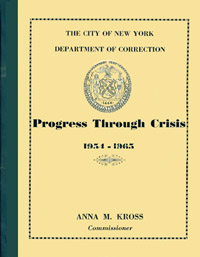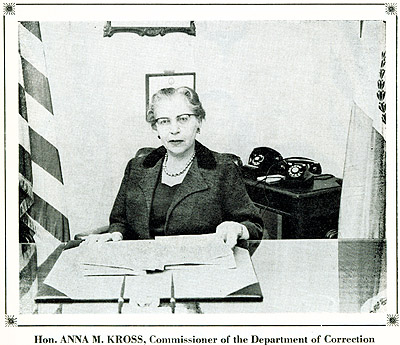
 |  |
|
tion, Department of Health, Education and Welfare, under the Vocational Education Act of 1963.
The Board of Education has provided staff for the MDT phase of the program at the Adolescent Division Institution and the existing Public School 616 provides specialized training for the program within its school curriculum.
Volunteer services on behalf of prisoners are an innovation introduced by this Administration on an unprecedented scale, particularly at the House of Detention for Women, but also at the Adolescent Remand Shelter in Brooklyn and to some extent on Rikers Island. For the first time in the history of the Department of Correction of the City of New York, the citizens of the City have been invited to enter the prison portals regularly, to assess the needs, and then to help fill them in every phase of the rehabilitation program.
Capital construction to relieve overcrowding and to provide adequate rehabilitation facilities has been entered into on a large scale by this Administration, following the blueprint laid down in our First Transmittal Letter of 1954. The most significant portion of the building program is the correctional complex now nearing completion on Rikers Island, the newer portions of it made feasible by the Rikers Island Bridge, now under construction. This Bridge, designed to make the prison community far more accessible, was planned and proposed by this Administration.
ON BALANCE we feel that we have proved that perpetuation of indiscriminate punitive imprisonment costs the community demonstrably more in finances, and infinitely more in terms of human suffering and deterioration than any foreseeable expenses that could be involved in the implementation of the scientific approach through a fully professionalized staff.
Scientific knowledge and methodology, teamed with education of the public whose understanding and co-operation we seek, are the ingredients which form our hope for the future of correctional effectiveness.
Now that we are finally off the ground after years of effort to involve the schools of higher learning in the professionalization of Correction — now is the time to forge forward with full speed ahead to the firm establishment of our Institute of the Behavioral Science in the doctoral and advance areas. It is our hope that this Institute once it is brought into corporate being, will master all the behavioral sciences into a full-scale and all-out effort to break through the impasse that humanity faces on so many fronts, and that now fills our correctional institutions to overflowing.
Rehabilitation of offenders has been our constant intent from the very beginning of our tenure. though all too often it has been hampered by the realities of budgetary and personnel shortages and of overcrowding that have plagued us from the very beginning and that have grown worse with the years, and by all the imponderables that can be included under the heading of traditionalism.
Our First Transmittal Letter, written after the grueling experiences of our first several months in 1954, contained an evaluation of the deplorable conditions that confronted this Administration on its assumption of duty, and detailed the essence of the rehabilitation program that we have been trying so hard to achieve during these twelve years of PROGRESS THROUGH CRISIS. [In printed book, the Foreword text concludes here.]
<<=== For Previous Foreword Page
|